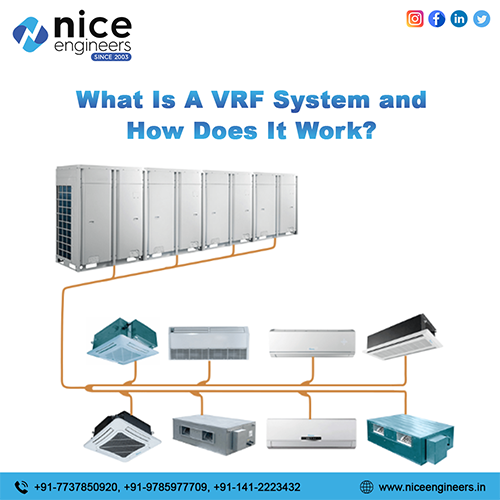You may have heard about boilers, heat pumps, AC, and furnaces. But some people may have yet to hear about a Variable Refrigerant Flow or VRF system.
These cooling and heating systems are strong, low-energy, adaptable, efficient, and offer quick ROI. If you want to know more about VRF, then keep reading the blog.
What is a VRF system?
VRF System or Variable Refrigerant Flow is the type of HVAC system that may offer both cooling and heating zones in a building. It consists of an outdoor unit connected to multiple indoor units and located at different zones or areas of the building.
Each indoor unit in a building is controlled individually to provide cooling and heating. The outdoor unit varies the amount of refrigerant that flows to each indoor unit depending on the required temperature in that particular zone.
VRF systems use variable refrigerant currents and variable speed motors instead of normal units, with a performance range of 0 and 1. They employ energy-efficient inverter compressors that can only partially handle heating or cooling loads.
How does the VRF system work?
Once you switch it on, this VRF system will measure the room’s temperature and then measure the temperature outside. It also operates the compressor at the right level.
With the help of the VRF system, your building will get multiple indoor units used by one outdoor condensing unit. The main difference is that they can provide both cooling and heating.
The VRF system uses advanced controls to monitor and adjust the temperature in each zone. This allows for precise temperature control and energy efficiency, as only the necessary amount of energy is used to heat or cool each zone. Additionally, the system can recover waste heat from areas that require cooling and use it to heat other building areas, further improving energy efficiency.
Advantages of the VRF system
The advantages of the VRF system which you can experience are mentioned below-
• This product does come in different sizes and types, which makes it fit for application. You can even find compact sleep equipment which is an excellent choice.
• Since the product is flexible in design, it becomes super easy for the person to install it. You do not have to call in the big cranes for the rooftop placement or anything.
• In traditional HVAC, you can turn it on or off. In the VRF system, heat and cool zones are different within a building, and occupants can customize the settings too.
• The system is quiet and does not disturb the occupants of the building when it is running. Unlike HVAC technology, it does not cause any noise.
Which Buildings Use The VRF System?
Like Air Conditioners, VRF systems regulate humidity, air circulation, purification, and temperature. It is a type of conditioning system that is suitable for any building in any form. But the only limitation of the application is the building’s height. Many schools, banks, historic buildings, offices, and commercial buildings use the system.

